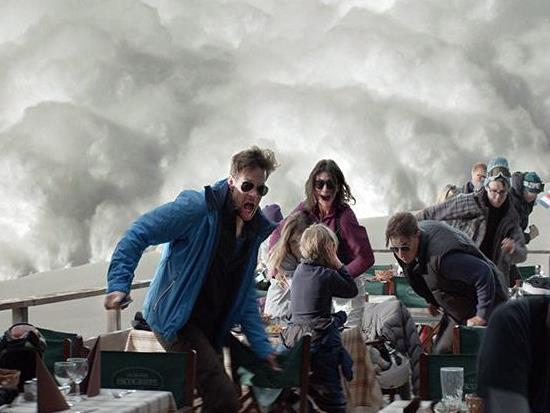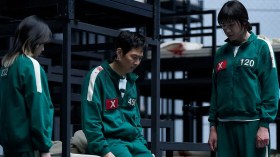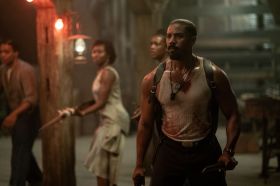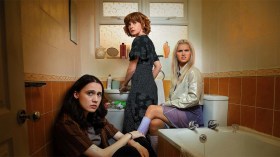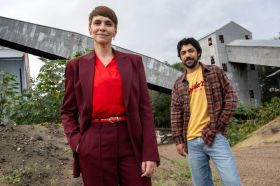Image: publicity still from the informative NZIFF site.
In 2009, Swedish director Ruben Östlund made a ten minute short, Incident by a Bank, which recreates a real bank robbery in 2006, based on the memories of witnesses, including its producer, Erik Hemmendorf. The film won the Golden Bear for the Berlinale Shorts Competition in 2010.
Replacing the crappy unsubtitled version of the film on Youtube which we published with the original version of this article is a glossy Vimeo deal. Here is the trailer, but you can get the whole thing for a couple of dollars.
Incident by a Bank by Ruben Ostlund from New Europe Film Sales on Vimeo.
On one level, as Östlund emphasises in his own description, the picture collides our collective vision of the way in which a bank robbery is supposed to happen with the messy reality of blundering desperation and accident. On another, it is a wonderfully comic story about a couple of idiots, a pathetic motor scooter, the random interventions of demonstrators in trucks, and a pair of quizzical witnesses who provide a running commentary.
The picture is also clearly about truth with a capital T – this actually happened, and is reproduced as exactly as possible. It has very particular pauses and a rhythm which incorporates waiting and trivia. There are no cuts to reaction or direct causes to take us into the action. Indeed, all the connections are made by this one continuous shot which moves from observer to observed, effect to cause.
It was shot in a continuous take, from high up, across a busy road, with a fixed 4K Red camera. The close-ups and pans are created entirely in the edit, as the image is zoomed in and out by up to 300%, so everything is clamped inside real time, and the shifts call attention to the way the story moves around its protagonists’ point of view.
A lot of the work is carried by the sound track, which enables the action to transcend the frame, to create multiple storylines and emphasise surprise and frustration. Much of the comedy is caused by the intersection between image and sound. It is a very funny film, but in a mischievous kind of way, built on delight rather than belly laughs.
That film really helps to explain why Force Majeure, Östlund’s current feature, is such a hoot. I interviewed him on the phone in Sweden, and the result was almost as messy as the Incident by a Bank.
Two prosperous Swedes have taken their picture-perfect children to a ski resort in France, so the family can spend some time together. According to Mother, Father is working too hard. There is a certain paired-down creepiness to the hotel, like a prison built of pale wood, with few guests but a cleaner who watches from an upper balcony like a relentless, unstoppable cosmic witness.
On the first morning the family are having breakfast on a balcony when the family is almost overwhelmed by a controlled avalanche – we get a pretty good clue to the whole film from the way the snow rolls down the hill and the guests gradually realize something is going wrong in a frame full of varied responses, all recorded in relentless, choreographed long shot as a tableau of transforming realities.
As the snow roars to the balcony, Father picks up his phone and his wallet and runs for cover. His wife protects the children. The scene in which we realize that the children realize exactly what Superdad has done is a fabulous piece of performance, and full of horror. The rest of the picture is about the family’s attempt to repair itself after this collapse of carefully fostered and plastinated social reality. At issue, again, is objective truth, and the way in which the reality of human behavior is different from our performed images of ourselves, of good and bad.
I took the opportunity to ask how that depiction of objective reality was embodied in the rehearsal process, because the performances seem to be enormously authentic.
‘I guess I have to go back to casting,’ Östlund said, ‘and the way I participate in casting, because I like to play with the actors.’
He improvised with the main actors in Force Majeure for two months, as it seemed that casting slid into rehearsal and contained a strong element of script development.
‘By doing this I give actors the knowledge about what the scene is like, to reconstruct it all out and find things I need to do in a different way. I can detect errors which are in the script because the script is it very often full of things that is not very easy-to-use when you are an actor.’
Even in the shooting, ‘I think it’s very very important that we are always reconsidering the script and rethinking about the scenery and the dialogue and have a continuous discussion about this. And then I give the actors a lot of time. I want them to feel secure – they should not be stressed. I do a lot of takes so they have a lot of time to get into their performances. Time and trust aee two main elements when it comes to directing actors.’
The shooting style has clear elements of Incident By a Bank, with wide and two-shots held without intercuts and cutaways, so we are seeing exactly what the director wants, rather than the usual conventions of story development.
The picture is intercut with truly lovely scenes in the snow, sometimes watching the preparation of the slopes in the dark while the family sleeps and gnaws at each other. It is no surprise that Östlund started in film as a director of ski instruction films. There is a sense of pure modernism about the style, especially after we discover the radio-controlled quadcopter that Father sends out in the night to roam between the blank, dark buildings of the hotel complex. While I was gurgling over connections to Antonioni and the Taiwanese director Edward Yang, he referenced Michael Haneke and his friend and fellow Swede Roy Andersson, who recently made A Pigeon Sat on a Branch Reflecting on Existence.
So much of the film is built around placing the camera to contain all the activity, and allowing the audience to explore within the frame. Was this a function of the visual aesthetic, or a way of giving the actors space?
‘I guess both. I wanted to do those wide-ranging silences that are in between two sentences, when we are waiting for someone to say something.’ For the audience, these moments become excruciating as we watch people decide to do something ghastly, and then – yes, they will! – do it in front of our very eyes.
The question of comedy took on a bizarre edge, though Östlund was simply interested in different ways of experiencing his material. The humour is often discussed in the reviews, and he certainly thinks it is funny. Darkly funny in a Scandinavian way, he said.
I didn’t laugh at all. I found it cumulatively horrifying. Part of this was about the cultural differences in comedy, which can also make Australian film difficult internationally. But I also watched the film alone, on a good home cinema system, and my response helps to show why the picture works so much better with an audience.
Beyond that social observation is the fact that I didn’t miss the laughter at all, because the film is ultimately driven by satire, rather than jokes and funny reveals. I kept thinking of Moliere and his coruscating observational power. But Östlund is expecting laughter.
‘Have you read the reviews in the US, for example?’ he asked I had the feeling, across the world on the phone, that he was pitying me for not getting the jokes.
The implications of the style on the shooting arrangements is pretty complete. The film took around 67 days to shoot, which he said is around twice the normal length for that kind of arthouse Scandinavian film. There are a huge number of takes, which are often long and require a lot of assembled detail for the actors – more like stage than film. The edit becomes an extended exercise in subtlety, working out which of the many alternatives work in themselves and in that place in the film, pushing the sound to move and punctuate attention, including a piece of Vivaldi’s Four Seasons which is repeated frequently to provide dynamic forward movement.
Force Majeure was shot comparatively conventionally, on an Alexa at 2K, so he had few opportunities to roam very far inside the frame. His spoke frequently about his previous film, Play, which was also shot at the higher density, and which he reconfigured extensively. His reminiscences almost had a quality of shell-shock. The trailer can’t convey the ambience and tension of those long takes.
“For me, Force Majeure is a very dynamic film,’ he said. ‘It compares to Play because we had 42 single shots that were on average over four minutes long, which was a real struggle to just look through the film and put it together. So the editing took a lot of energy and it was really hard to create any dynamics.
‘The big problem in the editing was to choose which take I should use. For example, I did over 120 takes of one scene in Play. We had maybe twenty takes that were really really good.’
I wanted to transcend his stories about filming to explore his inner logic in a post-Dogma Scandinavian way. We skittered around until I asked this question: ‘If I was a Hollywood producer, I would be asking why you are doing this, why you are giving the audience such a hard time?’
He laughed and said, ‘Of course one of the goals are my films is to make the audience reflect and think of their own lives and a lot of the movies that we are seeing don’t demand us to do anything at all except eat popcorn. We are looking at something that is not creating any thoughts – we go to the cinema and we don’t even remember what was seen watching.
‘If we want the audience to think new thoughts then I think it’s important to be unconventional, to have an expression that is not just copying or reproducing the same kind of cinema that we see. So I use a style of shooting that reflects why I wanted to be a filmmaker.’
‘I need to create limitations for myself because it creates energy. So for example, if I say we will take the scene from this angle on this camera position on this day and we will look at this afterwards, then it creates energy for me and everyone else to solve problems on set and not through the editing. And I think you can read a comfortable level when it comes to performance with actors and the engagement of everybody on set when you do it like that.’
‘It is a struggle to make a film, and every day you make a shot that is fantastic you are so satisfied with it, but the next day you have to leave this all behind. You are on this rollercoaster of emotions so I think it is very pleasing in an existential way, because you have those ups and downs constantly, and it makes your life so very dynamic.
‘There are some periods when it really is a struggle, but I guess I have the kind of mentality that you need to make feature films – the ability to work for a long time on the same project, and accepting in yourself to think about it over and over again.’
A friend of mine went to see Force Majeure entirely by accident, with no warning or background. ‘That was a fantastic film, and I loved it,’ she said happily. ‘But I didn’t realise it would be really, really strange…’
————
Force Majeure has the Jury Prize in the Un Certain Regard section of the Cannes Film Festival for 2014. It is screening on limited release, but won’t last long.
